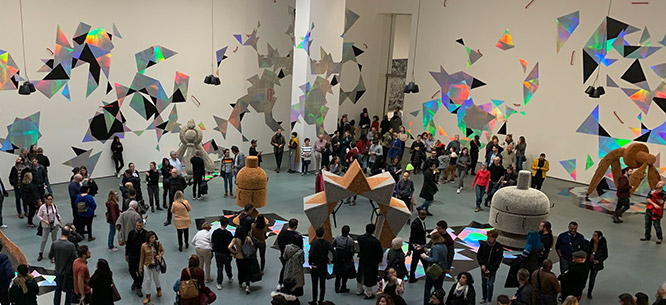What the New MoMA Leaves Out
What the New MoMA Leaves Out
The glowing praise for the redesigned MoMA’s embrace of diversity masks deeper historical problems.

Since the newly revamped Museum of Modern Art (MoMA) reopened last October, it has received near-universal acclaim. For Roberta Smith, art critic for the New York Times, the expansion opens a “second round of greatness,” one that tells a “different, more inclusive, less definitive story” about modern art than its predecessor. Hal Foster, writing in the London Review of Books, praises the expansion for complicating “the usual stories of modernist and contemporary art with a deepened attention to different cultural traditions as well as key technological transformations.” This account, Foster adds, “is both more accurate and more attractive, especially to young people of diverse backgrounds and media competencies.” Martin Filler, in the New York Review of Books, questions MoMA’s “perpetual state of aggrandizement” and “unending growth,” but goes on to reassure his readers that in the expansion little of value has been lost, while artists who have been “systematically marginalized if not fully excluded from mainstream museums” have been given long-overdue exposure.
At its best, the redesigned museum acknowledges that modern society rests on colonialism and exploitation, and that art as an institution reflects that reality. But the glowing praise for the new MoMA’s embrace of diversity masks deeper historical problems. The expansion lacks an adequate guiding idea concerning art in general and modern art in particular. It also implies that inclusion can be meaningfully advanced in the absence of a larger, historical conception and transformative political project. The new MoMA exemplifies that marriage of corporate greed and cultural liberalism that theorist Nancy Fraser has called progressive neoliberalism: it takes the basic structure of society for granted and focuses only on mechanisms of inclusion and exclusion. This approach offers a partial truth at best, and a misleading ideology at worst. Racism and sexism both rest on systems of dependent labor that have been and remain integral to the structure of modern capitalism. The relation of the artwork to that structure is at once more complicated, interesting, and revealing than the issue of exclusion allows.
The key decisions for any art museum are what objects to display and how to relate them to one another. Historically, for MoMA, the thinking behind these decisions was clear. Founded in 1929, MoMA was the first museum in Manhattan devoted to European modernism. At its core was a dazzling collection that began with Cézanne and ran through surrealism. Eventually, the museum put together a second sequence that began with Jackson Pollock and ended with the innovations of the 1960s and 1970s in feminist art, new materials, op art, and the work of Andy Warhol. These two sequences were and remain t...
Subscribe now to read the full article
Online OnlyFor just $19.95 a year, get access to new issues and decades' worth of archives on our site.
|
Print + OnlineFor $35 a year, get new issues delivered to your door and access to our full online archives.
|






